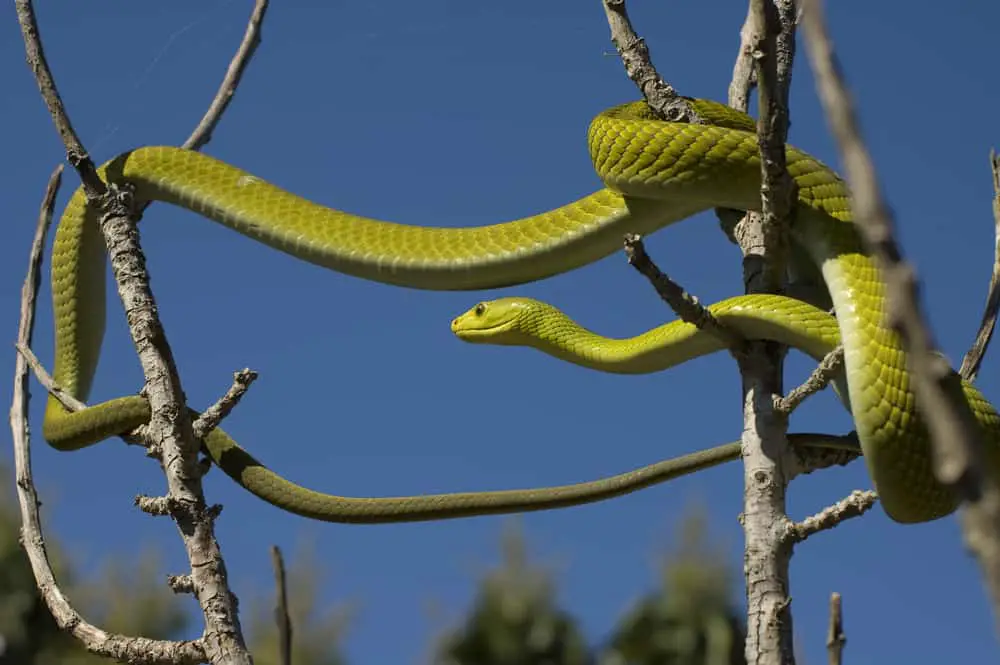
The Green and Black Mamba snakes are widely known and feared in Africa. Known for their toxic venom and ferocity, they are responsible for numerous human deaths.
Mambas are fast-moving venomous snakes of the genus Dendroaspis in the family Elapidae. Four main species are recognized; three are arboreal and green in color, whereas the black mamba, Dendroaspis polylepis, is largely terrestrial and brown or grey.
The four different types of mambas: the eastern green mamba, the western green mamba, Jameson’s mamba, and the black mamba, are all native to various regions in sub-Saharan Africa.
Table of Contents
- 1. The Eastern Green Mamba
- 2. The Western Green Mamba
- 3. The Jameson’s Green Mamba
- 4. The Black Mamba
- Conclusion
1. The Eastern Green Mamba
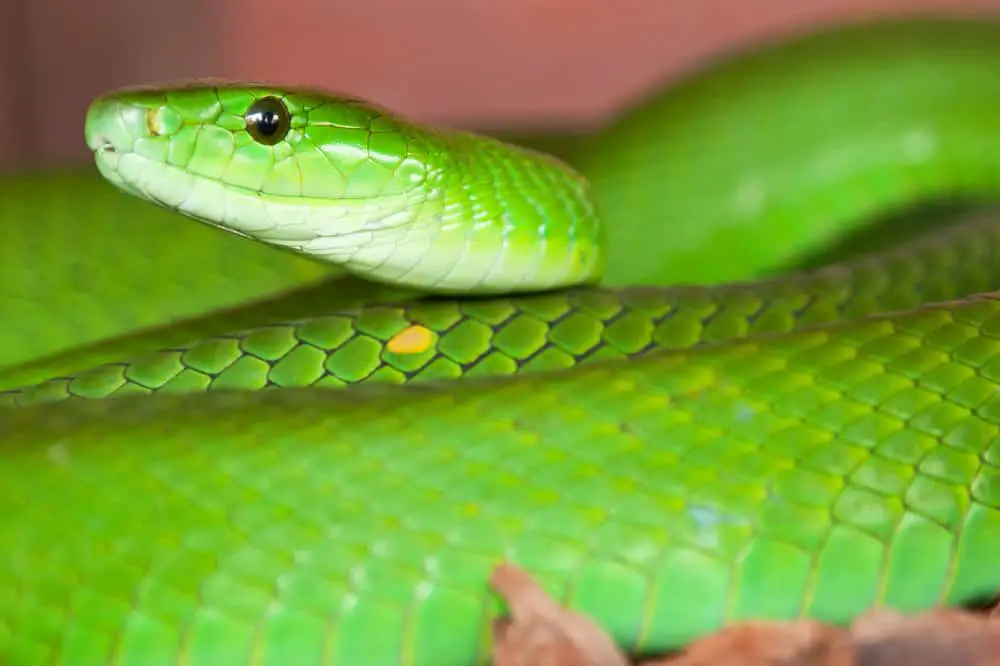
Classification
The eastern green mamba (genus Dendroaspis angusticeps), also known as the common green mamba, white-mouthed mamba, or East African mamba, is a moderate to highly venomous tree-dwelling snake. It was first discovered and observed by Scottish zoologist Andrew Smith in 1849, who first named it “Naja angusticeps.”
Physical Characteristics
The eastern green mamba is large, with a compressed slender body and a tapering tail with a long coffin-shaped head. In mature adults, the upper parts are a bright green (with occasional interspersed yellow scales), with the underbelly usually light yellowish green.
Juveniles are green-blue, becoming bright green when they reach around 75 cm (2ft 6 in) in length. They have medium-sized eyes with round pupils. The inside of the mouth is bluish-white or white, which gives it the “white-mouthed” nomenclature.
Adult males grow to a length of approximately 5.9 ft and females to 6.6 ft.
Range and habitat
The eastern green mamba is distributed across the coastlines of eastern and southern Africa from countries including South Africa, Mozambique, Malawi, Zanzibar, Tanzania, Kenya, and the eastern parts of Zimbabwe. There is also a distinct sub-species found primarily in coastal north-eastern South Africa to southern Mozambique.
It is a shy, elusive snake that spends most of its time in trees naturally well camouflaged. It is rarely found in open terrain, preferring dense tropical vegetation and forests. Some specimens have been located 4900 ft above sea level.
Behavior
A moderately active daytime ambush predator spends its days in a sit-and-wait position but has been observed hunting for prey such as sleeping bats. At night it can be found sleeping, curled up in a hollow trunk or foliage. It does sometimes come down to the ground to bask in the morning sun.
It is not thought to be a migratory snake, seen inhabiting the same location for days. It is inert and fairly inactive; it seems to move only around 18 ft a day on average. This creature can move at a speed of approximately 65 ft per hour.
The eastern green mamba’s prey primarily consists of birds, eggs, and small mammals, including bats and other rodents. It is also believed to eat arboreal (tree-dwelling) lizards.
The eastern green mamba is a reclusive solitary snake except during mating season in the rainy months between April and June. They compete fiercely with other males, sometimes to mate with a female or establish territorial dominance.
Females lay 10 to 15 eggs on average. The incubation period is approximately three months, and they give birth in October and November. They can live until 12 years; the oldest captive, the eastern green mamba, is 18 years old.
Threat to humans
Although regarded as having the least toxic venom of the three green mamba species, it is still highly venomous. It is the most commonly encountered species occurring mainly from September to February, during the breeding season.
Its proximity to humans occurs mainly from their tendency to inhabit farm trees such as coconut, mango, banana, and citrus. In rural areas, these snakes are common to stray into people’s houses and thatch roof dwellings.
What to do if bitten
The strike speed of the Eastern Green mamba has not been recorded. It does, however, strike repeatedly, given a chance. Its venom belongs to the three toxin family and contains a mixture of neurotoxins.
Envenomation symptoms include swelling and pain in the bite area, nausea, dizziness, breathing difficulty, and irregular heartbeat or convulsions. Paralysis may occur with neurotoxins.
First aid procedures include the application of a pressure bandage, keeping the victim as calm and immobile as possible and prompt evacuation to a clinic or hospital. Bites from neurotoxic venom are best kept isolated, so a tourniquet may be applied.
It is highly beneficial for the snake to be identified to ensure that the correct antivenom is administered. An anti-tetanus injection should also be considered.
Although considered life-threatening, healthy adults do have a very good chance of a full recovery.
2. The Western Green Mamba
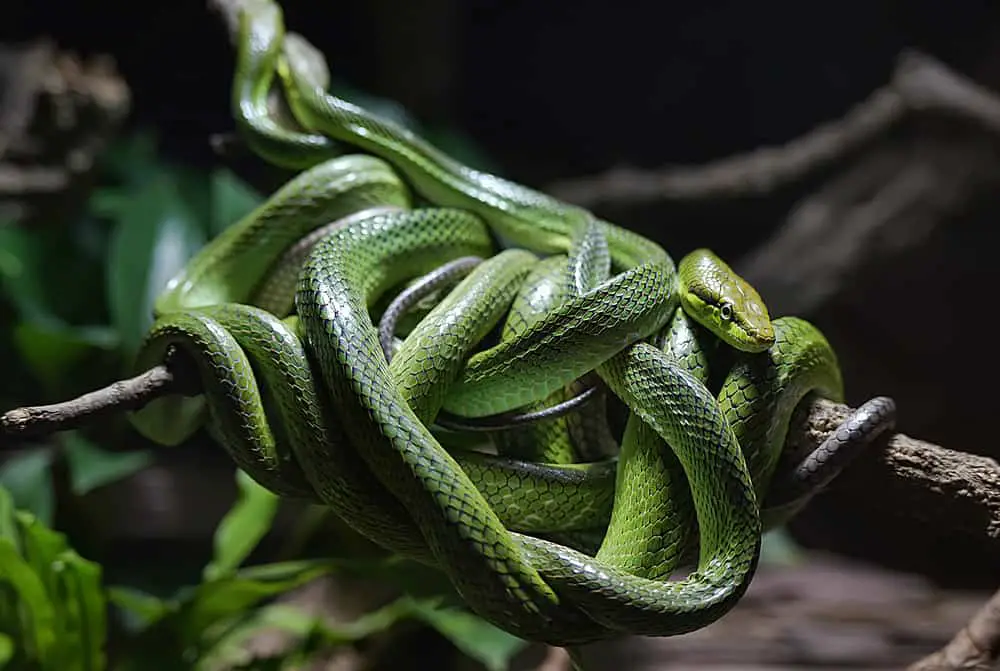
Classification
The western green mamba, also referred to as the West African green mamba, or Hallowell’s green mamba, is a venomous snake of the genus Dendroaspis (viridis). It was first discovered and described by the American herpetologist Edward Hallowell in 1844.
Physical Characteristics
This mamba has a long and slender body with a long tapering tail. It is bright green, fading to orange or yellow towards its tail. The head is long and thin with a distinctive canthus. The long thin head has a distinct canthus above the medium-sized eyes with round pupils.
The average length of an adult is around 6,9 ft.
This snake is often mistaken for a similar-looking species such a Boomslang or green bush snakes.
Range and habitat
An agile, active snake, the western green mamba inhabits western Africa’s woodlands and coastal rainforests stretching from Senegal in the west to Benin.
Behavior
The western green mamba is shy yet alert and a jittery snake. It is usually active in the daytime, hunting high up in the forest canopy. It usually sleeps high up in a tree branch. The distinguishing difference to the eastern green mamba is its tendency to also roam and hunt on the ground.
Its diet consists mainly of birds and mammals, as is the case with other mamba species.
The female typically lays between 6 and 14 eggs.
Threat to humans
The World Health Organisation regards this snake to be of medical importance in western Africa. Although interactions and the risk of bites on humans are relatively rare, the venom is highly toxic and more dangerous than the eastern green mamba.
Most records of encounters with these snakes occur in forested areas; however, they also seem to inhabit drier regions, including open savannas and may wander into suburban parks in towns and cities.
What to do if bitten
Urgent professional medical care, including antivenom for a bite from this snake, is critical.
Bites on humans are rare. The three-finger toxins are, however, considered life-threatening, and symptoms typically occur within 15 minutes.
The symptoms are similar to bites from the other green mambas but left untreated; the patient will eventually die from suffocation caused by paralysis of the respiratory system. This can occur in as little as 30 minutes.
3. The Jameson’s Green Mamba
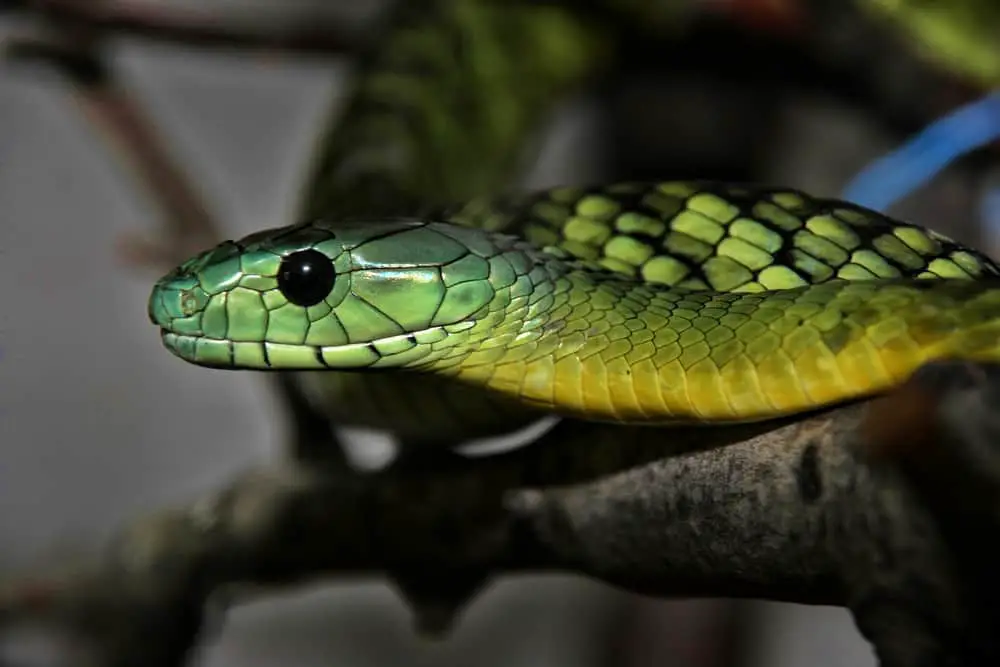
Classification
Jameson’s mamba (Dendroaspis jamesoni) was named after natural history professor Robert Jameson. It was discovered by a Scottish doctor, naturalist, and explorer Thomas Traill in 1843, who named it after his professor at the University of Edinburgh.
Two additional subspecies, the nominate and eastern black-tailed mamba from sub-Saharan Africa, have been recognized.
Physical characteristics
The Jameson’s mamba is a slender, large, long snake with smooth scales and a tapered tail accounting for up to 25% of its total length. Adults are usually dull green across the back to light green towards the underbelly, with scales generally black-edged. The underparts are typically yellow or cream. This snake has a narrow, elongated head with small eyes and round pupils.
An adult snake’s total length (including tail) is approximately 4 ft 11 in–7 ft 3 in. It may grow as large as 8 ft 8 in.
Range and habitat
Jameson’s mamba is widely spread geographically, mostly in Central Africa and West Africa, and even in some parts of East Africa. This can range from Angola, the Congo Republics, South Sudan, and Ghana in western Africa to Kenya and Tanzania in the east.
The Jameson’s mamba is an adaptable species found in rainforests, woodland, savannas, and deforested areas at elevations up to 7,200 ft high. Jameson’s mambas thrive in areas with extensive human settlement and deforestation and are often found wandering into buildings, town parks, farmlands, and plantations.
Jameson’s mamba is a highly arboreal snake, more so than its eastern and western mamba cousins and significantly more so than the black mamba.
Behavior
Jameson’s mamba is highly agile. Like other mambas, it can flatten its neck and mimic a cobra when it feels threatened, and its length and body shape gives it the ability to strike from a significant range. Usually not aggressive, it will typically attempt to escape rather than attack if confronted.
Not very extensively studied due to its natural camouflage coloring and preference for high trees, it is not known to hunt; instead, it likely assumes an ambush strategy when seeking prey, similarly to the eastern green mamba.
The diet consists of tree-dwelling mammals, birds, and lizards. They have also been observed accepting rodents in captive settings.
Predators of this species are mainly birds of prey, and others may include the honey badger, other snakes, and possibly mongoose.
Males compete and breed with females during the dry season, producing 5 to 16 eggs, sometimes depositing them in abandoned termite heaps.
Threat to humans
Also classified as a snake of medical importance by the WHO, there are few recorded snakebites, owing greatly to this mamba’s shyness and preference for trees. Over a 16-year study, most of these bites showed that the risk increased over the rainy season when both rural people and snakes were most active. Snakebites in cities are rare.
What to do if bitten
Like the neurotoxic venom of most other mambas, snakebite is a serious emergency, and speedy medical intervention is critical.
The usual effects of neurotoxicity, such as breathing difficulty and paralysis, are prevalent. First-aid options include keeping the victim calm, limitation of movement, and applying a tourniquet.
Although full recovery is highly likely with early medical intervention, death has been recorded within three to four hours of being bitten.
4. The Black Mamba
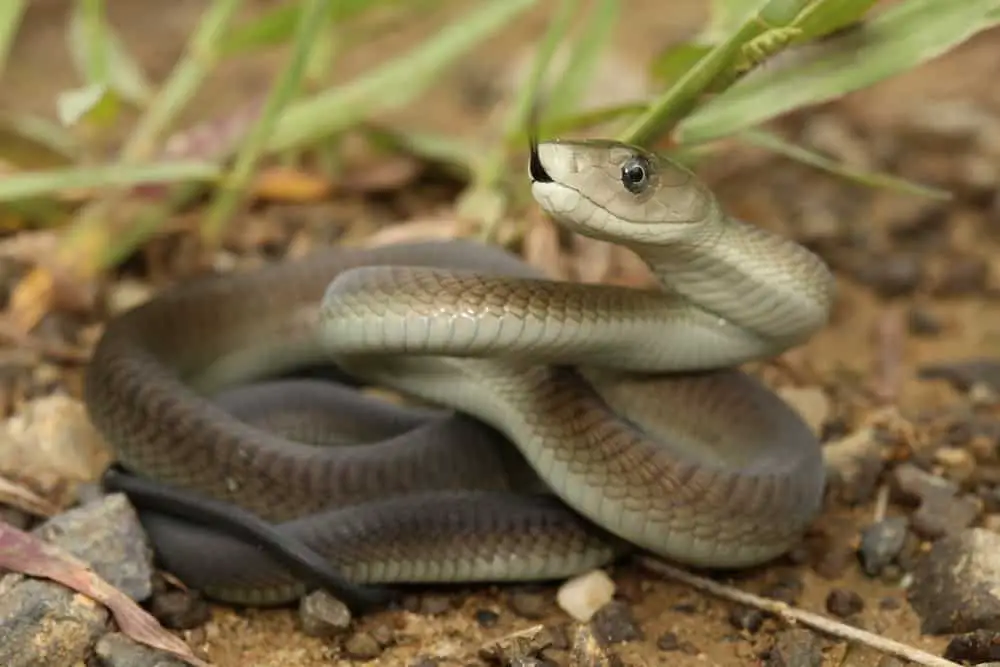
Classification
The black mamba (Dendroaspis polylepis) was first described by a German-born British zoologist Albert Gunther in 1864. This is the most highly venomous species of mamba belonging to the Elapidae family. Genetic analysis has shown that the black mamba is most closely related to the eastern green mamba.
Physical characteristics
The black mamba is long, slender, and cylindrical. It has a coffin-shaped head with a distinct brow ridge and medium-sized eyes.
Contrary to popular belief, black mambas are rarely black. Colors vary considerably in color and include olive, yellowish-brown, khaki, and gunmetal grey. The scales of some specimens may have a purple sheen. Black mambas have greyish-white underbellies.
The “black” mamba nomenclature is derived from the color of the inside of the mouth, ranging from a dark bluish-grey to nearly black.
Black mamba eyes range between greyish-brown and shades of black; a silvery-white or yellow color surrounds the pupil. Juveniles are lighter in color, typically grey or olive green, and darken as they mature.
It is the second-largest venomous snake globally, only after the king cobra, reaching a maximum length of 14 ft 9 in. It is the longest snake in Africa.
Their average weight is 2.3 lb but can easily reach a weight of 3.5 lb. It is a front-fanged snake with fangs up to 0.26 in in length.
Range and habitat
The black mamba inhabits most sub-Saharan Africa, although its presence in western Africa has not been established.
These giant snakes prefer moderately dry environments such as light woodland and scrub, rocky outcrops, and semi-arid savanna. It also inhabits tropical savanna and low-lying forests. It is not often found at altitudes above 3,300 ft.
It is rated as “least concern” on the International Union for Conservation of Nature endangered species Red List, based on its wide distribution across sub-Saharan Africa.
Behavior
The black mamba is equally terrestrial and arboreal and uses abandoned termite colonies, burrows, crevices in rocks, and tree hollows as shelter. Black mambas are diurnal, basking twice daily, once in the morning and again in the afternoon.
Highly strung and unpredictable, the black mamba is agile and a fast mover, reaching speeds above 12 mph. In the wild, black mambas do not tolerate humans approaching more closely than about 130 ft.
When feeling under threat, it will retreat, but when confronted, it’s likely to engage in a threat display, gaping its mouth and flicking the tongue. It will likely hiss and spread its neck into a hood similar to that of cobras.
It bites with a series of rapid strikes, leading to severe envenomation. This beast’s sheer size and raised head enable it to launch as much as 40% of its body length upwards, so mamba bites to humans can occur on the upper body.
It feeds mainly on warm-blooded prey such as rodents, birds, bats, and other small mammals. It will also consume smaller snakes. It usually hunts from and returns to a permanent lair.
The breeding season occurs in the warm months, between September and February. Rival males wrestle for dominance, as do all species of mamba. The female lays 6 to 17 eggs.
Black mambas have few natural predators but occasionally fall victim to birds of prey, such as martial and tawny eagles.
Threat to humans
Considering its attributes, it is no wonder that this is the most feared snake in Africa. Before a mamba-specific antivenom was introduced in 1962, the death rate from black mamba neurotoxic bites was very high.
Black mamba venom is so powerful that it can make a full-grown man collapse within 45 minutes after envenomation. Death is certain if an antidote isn’t provided and even with an antidote, the prognosis is not always positive.
What to do if bitten
Like the neurotoxic venom of most other mambas, snakebite is a serious emergency, and speedy medical intervention is critical. The usual effects of neurotoxicity such as breathing difficulty and paralysis are prevalent, and first-aid options include keeping the victim calm, limitation of movement, and applying a tourniquet.
Although death has been recorded within three to four hours of a bite, full recovery is highly likely with early medical intervention.
Conclusion
All mambas are fast, nervous, and lethal. They also are a beautiful species of snake that are best appreciated from a distance and deserve protection from us humans as they are a vital ecological contribution to the natural world.
References:
National Geographic: Black Mamba
World Atlas: The Venomous Mamba of Africa: How Many Species are There
Britannica: Mamba
Hluhluwe Game Reserve: Black and Green Mamba Snake
Animal Start: The Different Types of Mamba
Science Direct: Eastern Green Mamba



